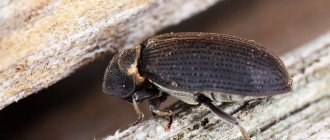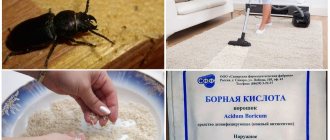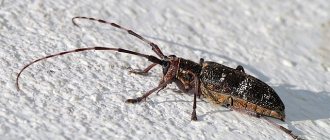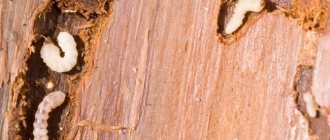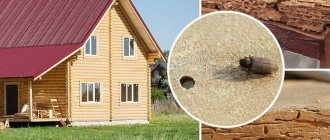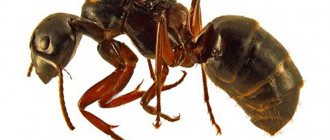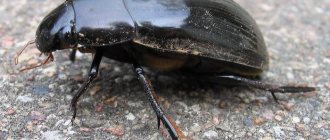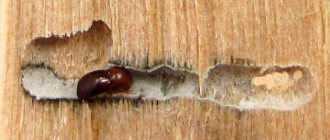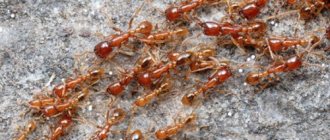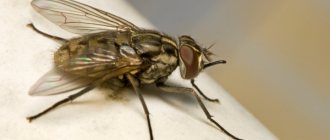Construction of a house or other structure involves the use of wood. They not only build houses from wood, but also make various structures for them, such as windows, doors, window sills, rafter systems, floors, etc. If pre-treatment of wood is not carried out before the manufacture of such elements of buildings and structures, then such structures will prematurely affected by wood-boring beetles. This beetle is also called the longhorn beetle, as well as the shawl.
You can determine the presence of a longhorn beetle if you listen carefully to the sounds. If an unpleasant rustling sound, in the form of a squeak, comes from the thickness of the wood, then this is the first sign that the wooden structures are collapsing. It is not the beetle itself that is particularly dangerous, but its larvae. During their stay in the thickness of the wood, they gnaw rather long passages, turning the wood into dust. The sooner you start fighting shashel, the greater the chance that the house will last for many years.
Not effective methods
Treatment with fog generators
Also, many one-day companies with fake seals and not registered offer to treat houses from bark beetles, borers, longhorned beetles and other pests with hot fog generators ( they pass this off as fumigation or aeration with insecticides ).
As a rule, insecticides used for such types of work are cheap analogues or products not intended for this type of pest ! When treating your home with fog generators, the fine dust that is formed during the operation of the generator will settle on all surfaces of your home, because Fogging agents such as glycerin or petroleum jelly are also used. You will be tired of scrubbing and washing your home after poor quality treatment.
In addition, the larvae of longhorned beetles, wood borers and bark beetles, in case of danger, clog their passages with feces and sawdust; the fog simply will not reach them and after a while the problem will resume . You can find out more about the principle of operation of the generator on this page about the hot fog generator
Wood injection
There is also a method of injection, in this case a specialist makes a hole in the wood with a millimeter drill and then injects the drug into it with an insulin needle. Because the tree is already dead and is unable to carry the current of water, resins and nutrients; the product must be drilled and injected literally every 3 centimeters.
Needless to say, your home is completely saturated with chemicals, the persistent smell of which will accompany you for many years . The whole tree will be riddled with many small holes, which will not add beauty. In addition, this method is extremely time-consuming and very expensive.
Appearance, why it’s dangerous
It is not easy to accurately describe this insect, since the grinder beetle is the collective name for a large group of insects. Most of them are small (2.5 to 5 mm) bugs that live inside the wood. At the same time, the main danger is not the beetles themselves, but the larvae. They are the ones who gnaw through passages, destroying buildings, living trees, and lumber.
The presence of these pests can be detected by small (2-3 mm) holes that appear on the surface of furniture, wooden parts of buildings, and tree trunks.
In houses or apartments with furniture affected by the grinder, sometimes in the silence of the night you can hear a characteristic sound reminiscent of the ticking of a clock. Some peoples call these sounds “the clock of death,” although their source is grinders who hit their heads against the walls of passages inside wooden objects. In this way they call females during the breeding season.
These insects pose the greatest danger to the load-bearing structures of wooden houses, as well as to antique furniture or objects of art. It is not possible to detect them immediately, since the insects hide in solid wood and do not show themselves outside. Sometimes the product turns out to be seriously damaged.
The beetles themselves pose a danger only from the point of view of population reproduction. The wood is spoiled by the larvae that are located inside the passages. It is difficult to get them out of there, so you have to fight the grinders with very complex and time-consuming methods.
Mechanical treatment of affected wood
The most radical way to combat the pest is to trim, saw down or cut down the affected areas of wood. You should use hand-held mechanical tools: electric grinders can spread dust to other areas, along with beetle larvae and eggs. It is better to place polyethylene under the areas to be treated, then all wood chips, dust and dust should be burned.
However, this method will be good only in the initial stages of the attack, when the pest’s localization zone is precisely known, and there is confidence that as a result of such decisive actions the overall structure of the building will not be damaged.
Wood processing
After thorough cleaning, the surface must be treated. There are several ways to process wood
BUT! This method can only help at the initial stage of infection or for treating individual logs, boards and structures.
- A mixture of turpentine and kerosene. The prepared mixture (3 parts turpentine to 1 part kerosene) must be taken into a syringe and injected directly into the pest's passages.
- Resin, carbolic acid and naphthalene should be mixed in equal parts and the resulting mixture should be poured into the holes and passages of the bark beetle.
- Vaseline oil. Using a syringe or pipette, fill the pest's passages with oil. The oil is odorless and non-toxic, so this method can be considered completely safe.
Folk remedies for pest control
Clogging the entrances and exits with a special sealant will be the next step after cleaning and treatment: it is necessary to cut off all escape routes for the pest. Silicone sealant is suitable for external surfaces, and acrylic for internal surfaces.
- The simplest method is boiling water. It should be used when the appearance of the wood does not play a big role. Boil water and scald all affected areas with boiling water, trying to get into the passages.
- Hot drying oil. The principle of action is the same as with boiling water: apply to the affected areas, paying special attention to the passages. Remember that the appearance of a wooden structure may undergo significant changes during processing.
- Special means to combat the bark beetle, which can be purchased at hardware and construction stores. Here it is worth remembering one feature: for processing you will need two products , one of them is an antiseptic, the other is a fire retardant (a drug that protects wood from fire). They must be applied separately from one another, and the layers must be allowed to dry for at least a day.
House beetle and its larvae
If during construction (repair) you are too lazy to treat lumber with anti-woodworm compounds, be prepared for their appearance in the wood.
Beetles that eat wood in our country are represented by a dozen different species with eloquent names: grinder, borer, weevil, hooded bark beetle and, finally, wood-boring beetle.
The people also gave him a second name - black house barbel. This miniature bug is also called the house lumberjack.
These beetles leave hidden tree labyrinths only during mating games: they crawl along window sills and circle around light bulbs at night.
Insects multiply exponentially: their voracious offspring (larvae) are capable of turning any wooden structure into dust.
A timber with oviposition, wedged among healthy boards, will provoke a massive spread of woodcutter beetles throughout the house, the owners of which will be in the dark about the scale of the disaster until they see holes and wood dust.
Consequently, they go out to fight the beetle when its population has already unforgivably increased.
You can also learn how to get rid of spiders in your apartment.
Treating wood with insecticides
When starting to treat wood with insecticides, it is important to follow safety precautions. Hands, eyes and respiratory organs must be protected . Use rubber gloves, goggles and a respirator for these purposes. When finished, wash your entire body well.
You can get rid of the bark beetle using chemicals containing cypermethrin, lambda-cyhalothrin (“Paragraph”) or organophosphorus compounds. Of the latter, products based on chlorpyrifos (Chlorpirimak, Sichlor, Averfos) and malathion (Karbofos, Fufanon-super, Medilis-malathion) have proven themselves well. But it is worth considering that these are professional insecticides and their use can cause harm.
Treatment with insecticides is carried out from the first ten days of May to mid-June. This is the period of time when beetles emerge from the larvae. After tasting poisoned wood, adult individuals die and the reproduction chain is interrupted .
In July, it is recommended to repeat the treatment to destroy the newly hatched larvae.
Who are the grinders
Name: Grinders or pretenders Lat.:
AnobiidaeClass: Insects - Insecta Order: Coleoptera - Coleoptera
| Habitats: | in wood, products, seeds |
| Dangerous for: | food |
| Means of destruction: | folk remedies, chemical |
Grinder beetle.
Representatives of the grinder species are also often called pretenders. This is a family of small bugs whose body length can range from 1 to 10 mm. The color of beetles, depending on the species, ranges from light red to black.
The body of representatives of this family most often has an oval, oblong shape. The antennae of grinder beetles have a comb or serrate surface and consist of 8-11 segments. They are found:
- in wood;
- seeds;
- cones;
- products.
Pheromone traps
Despite the widespread popularity of pheromone traps recently, it is still better to use them in the garden rather than in a wooden house . They will help to remove only adult individuals, but in no way affect the larvae .
homemade pheromone trap
This method is very controversial , and has its ardent supporters or opponents. There is an opinion that such traps can lure insects located within a radius of several kilometers: instead of the long-awaited deliverance from unexpected “guests,” their numbers can be increased several times.
Deep heating of wood
- Microwave against bark beetles, borers, wood borers.
Uniform heating of the material from all sides for some time contributes to the death of the pest. It will be problematic to carry out this procedure on your own due to the fact that you cannot do without professional equipment .
Our company, specializing in the extermination of insects and rodents since 2007, offers a relatively new, but already proven method of combating bark beetles and other pests - heating materials with high-frequency electromagnetic waves (microwave method) .
Which method is the most effective?
The microwave field destroys all insects: both adults and their larvae . The desired area is heated to 50-60˚C (the temperature at which any living pest dies) using a microwave emitter. The microwave field does not pose a danger to the surrounding area, and the appearance of the wood does not change under the influence of microwaves. This method works on exposed timber, logs and small lesions.
If the house is infested with a bark beetle or any other beetle - joists, rafters, ceilings. attic and hard-to-reach places - in this case fumigation is carried out with phosphine gas. The Fumigation method has proven itself to be effective in combating all wood-eating insects over a large affected area.
Wood-boring beetle: description
The pest is dark brown or black in color and is one of the representatives of the grinder beetles. Beetles are not large in size: only a few millimeters. You can't tell by their appearance that they can cause significant damage to wooden plantings or wooden structures.
They spend most of their life in the thickness of wood, actively destroying it. They come out after they turn into adult beetles. Adults are busy laying eggs. To do this, they find a suitable tree or wooden structure, gnaw a hole up to 6 cm deep, and then lay up to 80 eggs. After some time, larvae emerge from the eggs, which are busy constantly sharpening the wood, turning it into wood flour. They can stay inside a tree for up to 15 years, gnawing up to 40 km of passages during this time. As a rule, the larvae damage up to 99% of wooden plantations and other structures.
Wood purchasing rules: measures
- When buying a finished structure, you should definitely check it for the presence of bark beetles inside the wood. Multiple small holes and a bluish coating are a good reason to refuse the purchase.
- When choosing material for building a house, you should also carefully check it. An unscrupulous supplier may take advantage of your ignorance and provide contaminated building material.
- A tree with bark is more difficult to check for quality. Pay attention to the ends: there should be no holes, grooves, grooves or other signs of damage.
- The wood must be dry. The beetle is attracted to tree sap; in fact, it feeds on it, therefore, the drier the tree, the lower the risk of buying building material with a “surprise”.
- It is better to immediately treat a newly built house with antiseptics to protect against pests (“Anti-bug”, “Antishashelin”, “Wood healer” and others). The treatment is carried out three times with a break of three days. Remember that the antiseptic does not penetrate into the wood, so this treatment will only be good as a preventive measure.
- The floor, walls, ceiling and ceilings should be inspected periodically. At the slightest hint of the presence of a woodworm, one must take active action.
Preventive measures against bark beetles
Responsibility for most procedures to prevent damage to wood before use rests with those who harvest, mill, or store the wood.
However, those who use wood will also need to take certain precautions to reduce the likelihood of contamination of various types of wooden structures, as well as furniture.
Measures to prevent wood infestation by bark beetles include the following:
- Inspection of wood before purchase.
- Use properly charred or air-dried wood.
- Sealing wooden surfaces.
- Using chemically treated wood (wood preservatives or insecticides).
- Using good building design such as ventilation, drainage and proper spacing between the tree and the soil will reduce the moisture content of the wood, creating less favorable conditions for beetles to thrive.
- Central heating and cooling systems also speed up the wood drying process.

